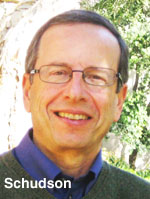J-school’s advice: Aid for pubmedia if it’s reconstructed
Local and watchdog news roles most vital, report says
A study on the future of American journalism commissioned by the Columbia University j-school sharply criticizes public broadcasting for failing to develop the local newsgathering capacity that would enable it to deliver on its mission to inform the public.
“The Reconstruction of American Journalism,” published last week and co-authored by former Washington Post Executive Editor Leonard Downie, who teaches at the University of Arizona, and Michael Schudson of Columbia’s Graduate School of Journalism, recommends new mechanisms to support “accountability journalism” — the in-depth watchdog reporting that they believe is most essential to a functioning democracy and at greatest risk where ad-supported news media are declining.
Public broadcasting could play an important role in providing accountability news coverage, particularly on the local level, but not without sweeping reforms redirecting financial support for local stations to newsgathering activities, according to the study.
“The failure of much of the public broadcasting system to provide significant local news reporting reflects longstanding neglect of this responsibility by the majority of public radio and television stations, the Corporation for Public Broadcasting, and Congress,” Downie and Schudson write.
They issued the second major study this month that looks to public broadcasting to help fill the coverage gap but finds it way behind the curve in joining the transformational shift toward digital media.
Two weeks earlier the Knight Commission on the Information Needs of Communities in a Democracy, a blue-ribbon panel convened by the Aspen Institute and the Knight Foundation, said pubcasting must “move quickly toward a broader vision of public service media,” one that is “more local, more inclusive and more interactive.” The Knight panel also touted policies promoting broadband access, digital literacy and a vibrant fourth estate (Current, Oct. 13).
The Columbia study is much more pointed in its criticism of public broadcasting and lays out precise proposals for reform: “In its next reauthorization of the CPB and appropriation of its budget, Congress should change its name to the Corporation for Public Media, support its efforts to move public radio and television into the digital age, specify public media’s local news reporting mission, and significantly increase its appropriation.”
Downie and Schudson also recommend broadening the CPB Board’s membership by adding appointees from non-political sources, such as national media leaders and the Librarian of Congress.
The study, posted on the Columbia Journalism Review website, can be found online through this link: tinyurl.com/reconstruct-journo.
After surveying the field for news chops and innovative thinking, Downie and Schudson conclude that too much of the money spent on pubcasting is directed to maintaining local television and radio stations and not enough to independent news reporting. “Overall . . ., local news coverage remains underfunded, understaffed and a low priority at most public radio and television stations, whose leaders have been unable to make or uninterested in making the case for investment in local news to donors and Congress,” they write.
They also note exceptions, including “quite impressive” news operations run by big multiple-outlet pubcasters — San Francisco’s KQED-TV/FM and Minnesota Public Radio and its California cousin KPCC in Pasadena — as well as MPR’s Public Insight Journalism initiative and NPR’s new Argo Project. But they also point to the “often dysfunctional, entrenched culture” of public TV and the recommendations of Tom Bettag, longtime producer of Nightline with Ted Koppel, who four months ago filed his recommendations for creation of a web-based public news site aggregating reports from public TV and radio. The report has not yet been released by PBS.
Downie and Schudson say pubcasting’s failure has as much to do with inadequate federal funding as it does with its choices for spending its funds. They call for CPB to redirect federal aid by requiring every publicly assisted station to provide local news coverage. CPB should also “increase and speed up its direct funding” for experiments in local news coverage for broadcast and web distribution and “aggressively encourage and reward collaborations by public stations” with other nonprofits and universities.
They call on CPB to “be more assertive in its efforts to consolidate duplicative public stations and signals” and to “encourage changes in the leadership of stations that are not capable of reorienting their missions.”
Much of the “Reconstruction” study assesses the altered landscape of American journalism, documenting the declines of daily newspapers and failures by all but a few commercial broadcasters to produce local news coverage of any depth or public-service value. They find bright spots in the fragile new-media ecosystem of such websites as Voice of San Diego (voiceofsandiego.org) and the St. Louis Beacon (stlbeacon.org, which, the report says, has a “makeshift newsroom” within KETC-TV in St. Louis). They point out that ProPublica, a national nonprofit startup that has attracted huge grants from foundations, relies on traditional news outlets to disseminate its investigative reporting.
The recommendation assailed most vigorously by critics was the study’s proposal to create a Fund for Local News. The fund could be backed by FCC-imposed fees on telecom users, broadcast licenses or Internet service providers. The funds would be awarded on an open, competitive basis by statewide councils modeled after the state humanities councils that dispense part of the National Endowment for the Humanities appropriation.
But the proposed subsidy was fifth among six recommendations to shore up the financial underpinnings and institutional support for substantive news reporting. Higher up was the need to clarify in the tax code that news reporting is an acceptable purpose for nonprofit organizations, and to specify the constraints required by that status. The report suggested a possible mechanism already used in several states: the low-profit limited-liability corporation (L3C) hybrid that lets investors help finance such groups, bringing together for-profit and nonprofit interests for socially useful purposes.
In addition, news units devoted to accountability journalism should enlist more philanthropic support, the report said. “Foundations should consider news reporting of public affairs to be a continuous public good rather than a series of specific projects under their control or a way of generating interest and action around causes and issues of special interest to them,” the study says.
Third on the list was the recommendation for pubcasting: “Public radio and television should be substantially reoriented to provide significant local news reporting in every community served by public stations and their websites. This requires urgent action by and reform of the Corporation for Public Broadcasting, increased congressional funding and support for public media news reporting, and changes in the mission and leadership for many public stations across the country.”
The co-authors also call on public and private universities to take on accountability news reporting as part of their educational missions in various ways — from operating newsrooms to supporting other nonprofit news organizations to serving as laboratories for innovations in digital news gathering and reporting. Their final recommendation called for increased access to public information.
In an Oct. 21 appearance on PBS’s NewsHour, Nicolas Lemann, dean of Columbia’s j-school, said the report has already helped to focus discussions on the future of journalism by “putting everything under one roof and making provocative recommendations. I’d like to see the debate move forward in a vigorous fashion into the policy realm.”
Comments, tips, questions? karen@current.org
Web page posted Oct. 29, 2009
Copyright 2009 by Current LLC

